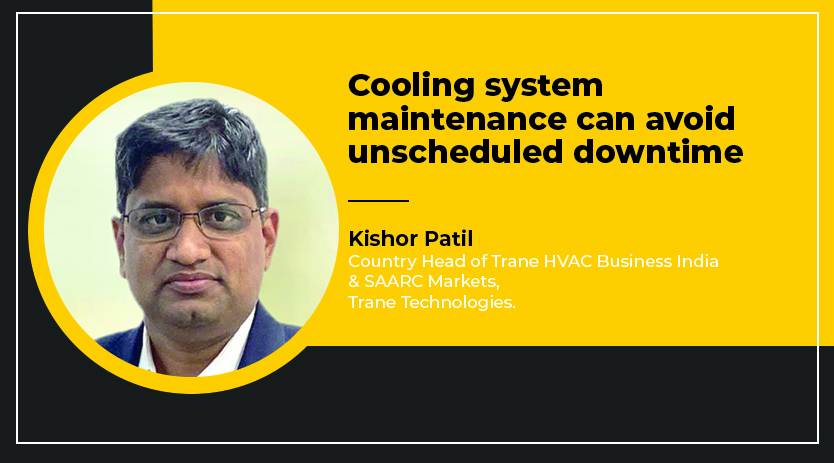According to Kishor Patil, Country Head of Trane HVAC Business India & SAARC Markets, Trane Technologies, effective strategies for managing the lifecycle of data centre cooling systems are essential for continuous performance improvement. These aim to achieve energy efficiency and identify potential cost savings through efficient design.
Please talk about data centres’ growth in the coming years.
As of 2022, India currently possesses a data centre power capacity of 637 megawatts (MW), with expectations for this capacity to increase to 1318 MW by 2024. The company views data centres as essential, driven by the demand to manage and offset the heat generated by numerous rooms filled with server racks and control systems that provide vital information. Our focus has been on Maxi, missing the potential of buildings to become more environmentally sustainable, dependable, energy-efficient, and future-ready. We are enhancing data centre capacity globally through our expertise and new-age technologies.
With the surge in data storage and processing demand, how are data centres adapting to meet growing requirements while maintaining efficiency?
Data centre operators are evaluated using a metric known as PUE (Power Usage Effectiveness), which measures the energy consumption that can be attributed to serving customers. Chiller efficiency and reliability are the primary factors contributing to the PUE calculation. This accounts for approximately 35-40 percent of the building’s power usage. We have engineered products tailored to meet the specific needs of the data centre industry, catering to a range from retail to hyper-scale operations. Our offerings include built-in solutions designed for different chilled water temperature ranges (with the ability to handle chilled water leaving temperatures of up to 27 degrees), solutions that can be customised in the field, and HFO solutions to enhance equipment efficiency.
How does the increasing capacity of data centres impact data localisation for better data protection?
The Indian government has established a committee of experts to investigate various issues related to data protection and offer specific recommendations for data security in India. Looking ahead, India’s data centre market is poised to substantially impact the country’s economic landscape, with expectations of a six-fold increase over the next six years. The emphasis on data localisation aims to prevent cybercrimes, promote local economies, and address growing concerns about privacy. It will safeguard citizens’ data within the country and enable the government to formulate improved policies.
This development has prompted numerous companies to expand their data centre operations, with major corporate entities like Adani, Reliance, Hiranandani, CapitaLand, Princeton Digital, Amazon, and Microsoft making substantial investments. Established players such as NTT, CtrlS, Nxtra, and STT have expanded their capacity. Data localisation regulations continuously evolve, requiring companies to review and adhere to them regularly. This will also reduce the risk factor. The stricter enforcement will lead to significant fines. With more robust regulations governing data privacy, we can align with customer expectations regarding using and transmitting their data.
Please discuss new cooling options to dissipate the heat generated by data centres.
Effective strategies for managing the lifecycle of data centre cooling systems are essential for continuous performance improvement. These aim to achieve energy efficiency and identify potential cost savings through efficient design. The strategies also help use highly reliable mission-critical cooling equipment to maintain server uptime.
Maintenance and operational practices also play a significant role in the inherent reliability and efficiency of the cooling system. Timely maintenance helps reduce, if not eliminate, unscheduled downtime.
The latest technological advancements lead to innovative cooling solutions tailored specifically for data centres, such as liquid cooling. Liquid cooling is easy to maintain, scalable, and cost-effective. The energy used in liquid cooling can be recycled to heat buildings or water. It effectively shrinks the carbon footprint associated with traditional air conditioning due to the application of advanced engineering coolants.

How significant is the market for liquid cooling solutions in data centres?
In 2023, the global market for liquid cooling in data centres is valued at $2.6 billion. Nevertheless, it is anticipated to expand significantly, reaching $7.8 billion by 2028, demonstrating a CAGR of 24.4% over the next five years. The increasing demand for efficient and space-saving cooling solutions is being driven by the growth of edge computing and the proliferation of Internet of Things (IoT) devices.
What steps are being taken to improve data centre performance through energy-efficient practices?
While accounting for the company’s carbon footprint, we focus on creating better and more efficient products that consume less power. This helps us reduce our carbon footprint as a lesser amount of fuel will be needed to generate. Additionally, we have expanded our product range to include solutions based on HFO (Hydrofluoroolefin) with a low global warming potential (GWP) of under 2, compared to traditional HFC (Hydrofluorocarbon) refrigerants with GWP as high as 1430.
Furthermore, we have integrated advanced Permanent Magnet motors into our air-cooled chillers to enhance efficiency. We have also incorporated free cooling options into our systems to leverage environmental diversity.
How do data centres ensure the safeguarding of sensitive information against cyber threats?
We place high importance on addressing cyber threats and comprehending their implications for businesses. Consequently, we have implemented standardised cybersecurity measures across our complete range of building automation systems. We are committed to maintaining the utmost data privacy for all our users. The controllers and software are equipped with Bacnet secure connected functionalities. They are designed to proactively guard against incidents through encryption, multiple layers of access control, and authentication methods to protect your data.
What sustainable practices must be adopted to address environmental concerns and reduce carbon footprint?
Global temperatures are on the rise due to shifting and unpredictable weather patterns. While this impacts various industries, data centres must consider and address climate change in their operations.
Given that data centres consume substantial amounts of energy, it is essential to seek ways to decarbonise. We have been at the forefront of sustainability efforts, introducing our 2030 Sustainability Commitment as early as 2019. This commitment includes a pledge to decrease customer-related greenhouse gas emissions by one gigaton, equivalent to 2 percent of the world’s annual emissions, and to achieve carbon-neutral operations.
One of the key initiatives to achieve this gigaton goal is the elimination of hydrofluorocarbon (HFC) and high global warming potential (GWP) refrigerants in cooling systems. In recent years, we have developed a strong product line with HFO-based solutions with a lower global warming potential (GWP) of less than 2, against the traditional HFC refrigerants with GWPs as high as 1430.
Cookie Consent
We use cookies to personalize your experience. By continuing to visit this website you agree to our Terms & Conditions, Privacy Policy and Cookie Policy.















